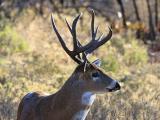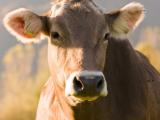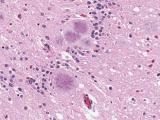Jun 30, 2004 (CIDRAP News) Follow-up testing has ruled out bovine spongiform encephalopathy (BSE) in an animal for which an earlier screening test was inconclusive, the US Department of Agriculture (USDA) announced this afternoon.
An immunohistochemistry test, the "internationally recognized gold standard" for detecting BSE, on the animal was negative, said Dr. John Clifford, deputy administrator of the Animal and Plant Health Inspection Service (APHIS), during a news briefing. The test was done by the USDA's National Veterinary Services Laboratory (NVSL) in Ames, Iowa.
The animal involved was the first of two for which rapid screening tests for BSE were inconclusive. The first inconclusive finding was announced Jun 25 and the second yesterday afternoon. Confirmatory testing in the second case is expected to take 4 to 7 days, Clifford said. Both cattle were kept out of the human and animal food supplies, he said.
Because the confirmatory test was negative in the first case, the USDA will not release any information about the animal or where it came from, Clifford said. He said details will be provided only if BSE is confirmed.
To expand its BSE surveillance program, the USDA commissioned several state veterinary labs to conduct rapid screening tests of cattle starting Jun 1. The agency said 8,585 cattle had been tested as of yesterday. The goal is to test more than 200,000 cattle over the next 12 to 18 months.
Clifford said the USDA will continue to announce inconclusive BSE test results as they are reported. When he was questioned about the rationale for that, he said, "We're going to have carcasses held while samples go to the National Veterinary Services Laboratory, and we recognize that information may be leaked, and that's why the decision was made to be very transparent and open with this information."
All inconclusive results will trigger confirmatory testing by the NVSL, Clifford said. In addition, the state lab will repeat the screening test when it is inconclusive the first time, but the USDA will do a confirmatory test even if a second screening test is negative, he said.
Clifford declined to predict how many screening tests will yield inconclusive results. A reporter cited another official's prediction that 1 in 10,000 tests could be inconclusive, but Clifford said that number was based on testing in Japan. "The Japanese are testing a different class of animals than we're testing, and we could see different results than what they're seeing, so we didn't want to put that number out there," he said.
He also declined to predict how many screening tests would turn out to be false-positives.
The USDA testing focuses on "high-risk" cattle, including those with signs of central nervous system disease, those that die of unknown causes, and those that can't walk. The agency also plans to test 20,000 apparently healthy cattle selected at random.
See also:
Transcript of Jun 30 USDA news briefing
http://www.usda.gov/Newsroom/0273.04.html


















